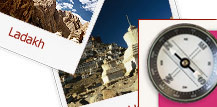

  |
|
| Ladakh TrekkkingToursLadakh TourismMonasteries FestivalsTrekking Adventure & ToursHotels in Ladakh |
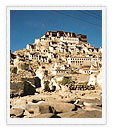 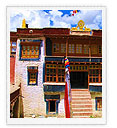 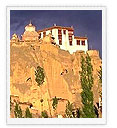 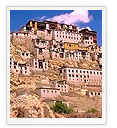  |
Ladakh Trekking Tours :: Ladakh MonasteriesLadakh MonasteriesMonasteries in Ladakh may be either of the Mahayana or the Hinayana sect of Buddhism. The head lama is called a 'kushak', meaning reincarnation. The monasteries of Ladakh are what give the region its unique flavor and beauty. Typically, most gompas are built so that they perch precariously on lone rocks or craggy mountain-faces. Hemis GompaHemis, the largest monastery in Ladakh,was built in 1630. It belongs to the red sect, Brokpa. It lies at a distance of 45 km south of Leh. Impressive and intriguing, Hemis is different from the other important monasteries of Ladakh. The annual festival, commemorating the birth anniversary of Guru Padmasambhava, is held for two days in June-July, enlivening the courtyard of the monastery. The festival of dances, where good triumphs over evil in a colourful pageant, is also the annual 'bazaar' where Ladakhis from remote areas buy and sell wares.Namgyal Tsemo GompaThe Namgyal Tsemo Gompa, built in 1430, contains a three-story high Buddha image and ancient manuscripts and frescoes. The fort above this gompa is ruined, but the views of Leh from here are breathtakingly beautiful.Sankar gompaThe Sankar gompa is located a couple of kilometers north of the town center. The gompa belongs to the Gelukpa order and has an impressive impression of the Buddhist deity Avalokiteshwara Padmahari or Chenresig, with 1,000 arms and an equal number of heads.Shanti StupaThe Shanti Stupa was built by a Japanese order and was opened by the Dalai Lama in 1985. From the top, one can view the exotic locales nearby. The stupa is located at a distance of 3 km from the Fort Road.Likir MonasteryLocated around 52 Kms from Leh, know as Klu-Kkhjil (water spirits) founded in the 11th century AD and was rededicated to another monastic order (the yellow sect) in the 15th century, its earlier gompa was destroyed in fire. The present gompa dates back to the 18th century. It contains huge clay images of Buddha and various old manuscripts. It also houses an interesting collection of thankas, old religious and domestic costumes and implements etc. . In the 15th century lhawang Lodos Sangphu caused the monastery to flourish. This monastery also belongs to Gaylukpa school. Every year from the 17th to 19th of the 12th month the Likir festival is held.Spituk MonasteryShanti Stupa in Ladakh Spituk Gompa is on the hill top near Indus, around 18 Kms from Leh. The Gompa was founded in 11th century by Od-De The Gompa was named Spituk (exemplary) by Rinchen Zangpo, a translator came to that place and said that exemplary religious community would rise. Initially it belonged to the Kadampa school then during the life time of king Gragspa Bumide made it Gayluk Pa order.The Spituk festival held every year from 17th to 19th days of the 11th month. It houses a collection of ancient masks, antique arms, icons and numerous thankas. Higher up the hill is the Mahakal Temple, containing the shrine of Vajrabhairava. The terrifying face of Vajrabhairva is unveiled only at the annual festival in January.Cave MonasteryThe cave monastery of Shergole is small but this old Buddhist monastery has elegant frescoes. It juts out of a brown, granite cliff and appears as if suspended in the middle of the mountain. This architectural quirk makes it an object of curiosity among local people too.Thiksey MonasteryTikse Monastery in LadakhAbout 20 kms from Leh, Thiksey is an imposing monastery and one of the finest example of Ladakhi architecture. This Gompa is situated on the top of the hill and forms part of Gelukpa order. Paldan Sherab nephew of Sherb Zangpo, founded Thiksey monastery.The 12 storey monastery complex contains numerous stupas, statues, thankas, wall paintings, swords and a large pillar engraved with the Buddha's teachings,there are sacred shrines and a many precious objects to be seen. The successive reincarnation of the Skyabje Khampo Ringpoche act as incharge of the monastery. Thiksey gustor (festival) held from 17th to 19th day of the 12th month. The main prayer hall has a 15 mt high seated Buddha figure,There are chance to see prayer in the early morning. Lamayuru MonasterySpectacularly set, founded in the 10th century,Lamayuru monastery is about 125 kms. west of Leh. As the legend goes, Lamayuru was a lake. It was blessed by a Lama after which the water of the lake receded up to the mountains leaving place for the monastery to be built. Now mostly in ruins, only the main hall exists today and houses numerous tankhyas. The Yundrung Kabgyad festival is held during summer on the 28th and 29th days of the 2nd Tibetan month. Lamayuru has fascinating caves carved out of the mountainside. Also known as Yung Drung (Swastika) it is sited on a high promonotory overlooking the village and valley. For sheer spectacle value no other gompa can match LamayuruShey MonasterySituated on a hillock 15 km south of Leh, was once the residence of the royal family & it was constructed by the first king of Ladakh, Lhachen Palgyigon. According to tradition, it was the seat of power of the pre-Tidetan kings. Around 12 Ft. Shakyamuni Buddha's statue made by copper guilt is the largest in the region, built by Deldan Namgyal in 1633 is a funerary memorial to his father, king Singee Namgyal. There is another statue of the Buddha three stories in height.Stone carving and many chortens are scattered around the Dresthang Gompa. On the 30th day of the 1st Tibetan month celebrates shey rul-lo and on the 10th day of the 7th Tibetan month the festival of Shey Surb-lo is held.Stakana MonasteryBuilt nearly 1580 by great scholar saint chosje Jamyang Palkar during the reign of king Jamyang Namgyal. The Stakna monastery is 45 Km south of Leh, founded on a hill shaped Stakna (Tiger nose). Easily accessible from Leh town.Stok PalaceVisible in the distance, at the top of a huge moraine of pebbles swept down from the mountains, the elegant four-storey Stok Palace stands above barley terraces studded with threshing circles and whitewashed farmhouses. Built early in the nineteenth century by the last ruler of independent Ladakh, it has been the official residence of the Ladakhi royal family since they were ousted from Leh and Shey two hundred years ago.A former member of parliament, still lives here during the summer. One of the room is converted into Museum. The fascinating collection comprises some of the family's most precious heirlooms, including antique ritual objects, ceremonial tea paraphernalia, and exquisite sixteenth-century thangkas illuminated with paint made from crushed rubies, emeralds and sapphires. The pieces de resistance, however, are the Gyalmo's peraks. Still worn on important occasions, the ancient headdresses, thought to have originated in Tibet, are encrusted with slabs of flawless turquoise, polished coral, lapis lazuli and nuggets of pure gold. Also of interest are a couple of swords whose blades were allegedly tied in knots as a demonstration of strength by king Tashi Namgyal Phugtal Gompa. Phugtal GompaThe Phugthal complex spills out of the mouth of a huge c Phugtal Gompa in Ladakhave high up in the sheer mountain face of a lateral gorge through which a major tributary of the southern Lungnak (Lingti-Tsarap) River flows. Perhaps, the most isolated monastic establishment of Zanskar, its foundation date back to the early 12th century ; at least one old chappel, among the several several of which it is composed, has frescos and ceiling decorations reflecting strong Indian artistic and iconographic influence. Phugthal is accessible from the Padum-Manali trekking route through a 7 km long trail that branches off from the Purney Bridge on the main trail. This unique monastic establishment is inhabited by a resident community of about 40 monks.Alchi GompaOn the banks of the Indus is the Alchi Gompa, dating thousand years back. One of its walls features thousands of miniature sized pictures of the Buddha. Three large sized images made of clay and painted brightly are its focal attraction. No longer an active religious center, it is looked after by monks from the likir monastery.Leh PalaceLeh Palace in LehThe captivating Leh Palace rises from the edge of a hill overlooking the town and stretches out towards the indigo sky. A miniature version of the Potala in Lhasa, the Leh Palace is one of the major attractions in ladakh. The palace was built in the 17th century and had nine storeys , but it is now dilapidated and deserted. It was the home of the royal family until they were exiled to Stok in the 1830s. Above the palace, at the top of the Namgyal hill, is the Victory Tower, built to commemorate Ladakh's victory over the Balti Kashmir armies in the early 16th century. This palace built for King Singge Namgyal, now houses the Ladakhi branch of the Indian Government's archaeological conservation organisation.Zongkhul MonasteryThe spectacular cave monastery of Zanskar, Zongkhul, falls on the Padum-Kishtwar trekking trail, just before the ascent of Omasi-la Pass begins. Situated like a Swallow's nest on the rock face of the Ating George, the monastery is associated by legend with the famous Indian Yogi, Naropa, who lectured in the Nalanda and Vikramsila Universities. The two caves present in the monastery are said to have been used by the famous Yogi for the solitary meditation. A footprint on the stone near the ingress of the lower cave is reserved as that of the yogi. The frescos on the cave walls are very old and reflect a high degree of artistic achievement. These are believed to be the original murals executed by Zhadpa Dorje, The celebrated scholar-painter of the same monastery who was active about 300 years ago. |